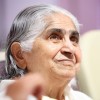
On 27 September 2014 the Prime Minister of India, Mr Narendra Modi, called for the UN General Assembly to assign a special day as The International Day of Yoga. In his address he said:
‘Yoga embodies unity of mind and body; thought and action; restraint and fulfilment; harmony between man and nature; a holistic approach to health and well-being.’
The UN designated 21 June and this year, the day will be celebrated for the first time by the United Nations across the world. This has brought yoga into the limelight and with the growth of Mindfulness and other forms of meditation and yoga it would seem that the mind and the spirit are now receiving unprecedented attention in all walks of life. Politicians, university students, schoolchildren, military personnel, health care workers, and others are beginning to consider the hitherto unthought-of benefits of a calm and ordered state of mind. The key word is harmony; between the mind and the body, between each one of us and nature and in all our relationships. While yoga programmes have been initiated in a multitude of institutions, a great many of them have adopted the physical exercises and postures of different yoga styles. These programmes focus more on the bodily benefits, and less on the effects of yoga and meditation on the consciousness and the spirit. Raja Yoga, as taught by the Brahma Kumaris, has a focus on the spirit. Raja Yoga deals with the divine spark of eternal, spiritual light that is the soul and concentrates on the communion between the individual soul and the Supreme Soul with truly life- changing results. Watch this space in the coming months for stories from across the world of the amazing diversity of those who take benefit from Raja Yoga starting with:
BSF starts yoga for troops to combat stress, sleep deficiency
Conversations of Peace: Celebrating the International Day of Yoga
Travelers and Yoga Lovers: Celebrate in Italy
Reflections on YOGA
in
Preparation for the International Day of Yoga on 21st June 2015
in
Preparation for the International Day of Yoga on 21st June 2015

Leading up to and during the forthcoming International Day of Yoga you may be challenged to explain various aspects of Raja Yoga as taught by the Brahma Kumaris. This may include questions like:
• Where does BK Raja Yoga sit in relation to all the other Yoga’s
• It’s relationship with Patanjali’s version of Raja Yoga
• Exactly how it’s aims and practices are distinct from other ‘Yoga’s’
These brief notes and reflections are designed to give you an overview and some specific insights in response to the above questions. You will naturally find your own way to say it.
Throughout history, different forms of yoga have arisen and evolved. Each focusing on specific methods and practices in order to achieve anything from personal liberation from illusion and suffering to the perfection of consciousness and character; from restoring an accurate relationship between mind and body to knowing the bliss that arises with self realization; and an intimate relationship with God in which all sense of separation has dissolved.
The word yoga itself means ‘union’. It generally refers to the union of the individual consciousness or soul with the Universal Consciousness often referred to as God. With the modern day emphasis on physical health and fitness many people think of yoga only as physical exercises – asanas or postures – but these are only the superficial aspects of what has been termed ‘the science of unfolding the infinite potentials of the human mind and soul’.
There are various ‘paths of Yoga’ that lead in some way toward this goal. They include:
• Hatha Yoga – a system of physical postures, or asanas, whose higher purpose is to purify the body, giving one awareness and control over its internal states and rendering it fit for meditation.
• Karma Yoga – selfless service to others without attachment to the results and the performance of all actions with the consciousness of God as the doer.
• Mantra Yoga — centering the consciousness within through japa, or the repetition of certain universal root-word sounds representing a particular aspect of Spirit.
• Bhakti Yoga – all-surrendering devotion through which one strives to see and love the divinity in every creature and in everything, thus maintaining an unceasing worship.
• Jnana (Gyana) Yoga – the path of wisdom, which emphasizes the awakening of the intellect (opening the third eye) and then applying its ‘discriminative intelligence’ to achieve spiritual liberation.
• Raja Yoga – the royal or highest path of Yoga, immortalized by Sri Krishna in the Bhagavad Gita and formally systematized in the second century B.C. by the Indian sage Patanjali, which combines the essence of all the other paths.
Raja Yoga is often associated with Patanjali’s Yoga Sutras. However, while Raja Yoga as taught by the Brahma Kumaris Worldwide, does include some of the same principles and practices of Patanjali’s Raja Yoga, perhaps the two most distinctive differences are:
1 The practices of Brahma Kumaris Raja Yoga can be easily integrated into the contexts of work and family life.
2 Brahman Kumaris Raja Yoga places specific emphasis on cultivating a ‘personal relationship’ with God, not as a religious belief or duty, but as part of one’s natural spiritual awakening and realization of one’s self as a spiritual being
The Result of Practice
The ‘effects’ of the practices of Brahma Kumaris (BK) Raja Yoga are different for each person depending on the tendencies and traits that they bring to their practice and how focused and consistent they are in their practice. Yet the ultimate aim or goal is the same for all, which in essence is:
• The realization of self as a being of spiritual energy (soul)
• Re-union with the Source of spiritual energy (Supreme Soul or God)
• The capacity to maintain the consciousness of being an actor playing many roles on the stage of life (Drama).
Alongside the practices of soul consciousness, meditation and contemplation, BK Raja Yoga offers a clear and precise body of knowledge which allows practitioners to ‘fast track’ their efforts and endeavors towards the liberation from illusion, the perfection of their consciousness and reunion with the Source. This knowledge, insight, and understanding largely derives from the founder’s own practices and his own unique personal relationship with the Source (God) over the course of thirty years.
What Brahma Kumaris Raja Yoga is NOT!
• It is not a doctrine that is preached in order to convert.
• It is not a philosophy or belief system that is ‘imposed’ on others.
• It is not used to attract and impress others in superficial ways.
• It is not a vehicle or method for controlling others.
• It does not attempt to break others faith in what they may already hold to be true.
• It does not seek to fragment relationships in any context.
• It does not seek to create discord at any level.
What Is Raja Yoga (as taught by the Brahma Kumaris Worldwide)
Raja Yoga is… the personal integration of the four daily practices of meditation, contemplation, application and contribution.
Practitioners are guided by a clear understanding of the true identity and nature of ‘the self’, the true identity and nature of the source of divinity, often referred to as God, and how humanity as a whole evolves through ‘time’ and in the physical ‘space’ we call Earth.
• Meditation – is the cultivation of an awareness of self as a spiritual being/soul and the ability to reconnect with the original core energy of the self/soul.
• Contemplation – is the deliberate reflection on the received information/insights into the nature of soul, God and humanity’s development. This awakens deeper levels of consciousness and induces realization. Contemplation is also reflecting upon and learning from ones own ‘insperiences’ as a result of applying such realizations on a daily basis.
• Application – is putting into practice the realizations that arise from meditation and contemplation while ‘allowing’ ones deeper wisdom to emerge and inform ones decisions and actions.
• Contribution – is being of ‘service’ to others in ways that help them to awaken their consciousness to the reality of who they are and the true nature of life and living in the world.
Raja Yoga as a Way of Life
During the process of practicing each ‘practitioner’ will ‘insperience’ some, if not all, of the following results:
Centering and INTEGRATIVE
As the practice of Raja Yoga is integrated into daily life it becomes a ‘way of life’. As the practitioner realizes their true identity as a spiritual being, often referred to as ‘soul’, they become centered. The tension and stress that often comes with the search for a ‘balanced life’ disappears. From a ‘centered’ state of consciousness balance arises naturally. The fragmentation of the self that is the result of the creating many identities based on role, gender, race etc. comes to an end as the practitioner ‘integrates’ all their roles and learns to ‘play the role’ instead of seeking a sense of identity through the role.
Cleansing and RESTORATIVE
Through the consistent practice of meditation and contemplation the practitioner clearly sees the many illusions and delusions that have been assimilated over time and now form many layers of false beliefs within consciousness. Practice gives rise to ‘realization’ of what is true for oneself, which has the effect of cleansing consciousness i.e. cleansing the self/soul of illusion. This also has the effect of gradually and gently restoring the self to its true and original state of being.
Mastering and AFFIRMATIVE
When the realizations that occur through the practices of meditation and contemplation are ‘applied’ daily in the context of action and interaction, the practitioner gradually restores their mastery of their own mind, intellect and personality. Old mental habits and emotional tendencies, which previously contributed towards the sabotaging of the self, atrophy and disappear. The ‘sovereignty of the self’ is gradually re-affirmed’.
Freeing and UNITIVE
Implicit in the practice of Raja Yoga is the recognition that the self/soul is not free. Through the four practices it is realized that where there is any kind of attachment there is not true inner freedom. Attachment is recognized as the root cause of all stress, suffering and sorrow. As the self cleans out and frees itself old beliefs and habits, old perceptions and attitudes, to which the self had become attached, there is a gradual increase in contentment and joy, the two main forms of happiness. When non-attachment is realized to be the most ‘natural’ state of consciousness it allows the practitioner to ‘connect transparently’ with others without any personal agenda/desire. This results in both a vision and a feeling of unity in relationship with others regardless of any personal histories.
Elevating and INTUITIVE
One of the hallmarks of Brahma Kumaris Raja Yoga is the practitioner’s pure intention to restore and maintain a personal connection and relationship with God. As a result many onlookers often mistake Raja Yoga for ‘just another religion’. Seldom is it recognized that the effort to be in a state of union with the Source is actually the process by which human consciousness is ‘elevated’. It is lifted out of the habits through which the self has kept itself in a state of suffering and darkness. Those habits are often referred to as ‘the vices’. As the practice of Raja Yoga becomes natural so the soul ‘casts off’ the veils of illusion accumulated over time. Vices are replaced by virtue. Not only is consciousness purified of its violent tendencies it naturally becomes more ‘divine like’. As a result the soul is able to access and re-emerge it’s own knowledge and wisdom intuitively.
Author: Mike George





